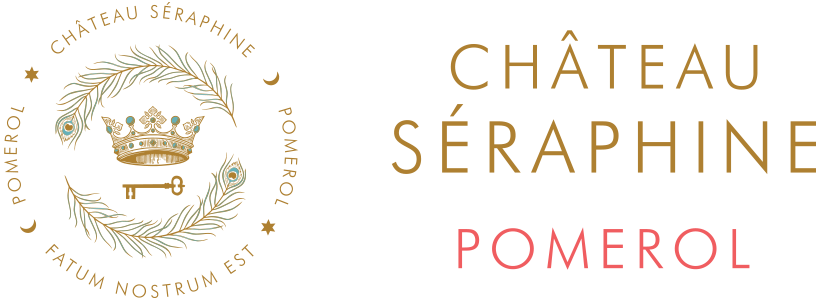L’Innocence de Séraphine 2021
“Inkily dark to the rim with a nose of cedary, creamed red and black fruits, some distant spice, velvety with a lovely savoury note and just a hint of seriousness behind. On the palate fresh, spiced, exotic black fruits, green spices with cool, substantial supple tannins, less savoury than the nose and with a tight, structured finish.”
— Nicola Arcedeckne-Butler MW
Tasting Note
An opulent deep ruby in colour, on the nose this wine shows a medley of blackberries, cherries, blueberries, and violets, followed by crushed peppercorn, cloves and hints of cedar and cigar, which flow deftly on to the palate. The purity of the fruit is underpinned by fresh acidity that runs consistently throughout, giving the wine an overall vivacity and life-affirming energy. A long and slightly savoury finish offers further sensory interest with the tannins that are ripe and knitted. It is a wine of elegance and poise.
Vineyard
Our vineyard has an overall surface of 2.2 hectares but is split into two parcels of vines. At Plince, we have 1 hectare of vines situated on a well-draining slope of sandy topsoil over clay and deep gravels and 0.4h of this plot was replanted with Cabernet Franc in April 2017 at 8000 vines per/h.
The second block at Mazeyres is 1.2h and is also laid out in two distinct sections. The first part consists of a raised deposit of deep gravels on 0.6h and is planted with old Merlot vines. The second part sits on a gently sloping 0.6h and is a patchwork of shallow sandy soils over gravels and blue clay (smectite) and was replanted with Merlot in April 2017 at 8,000 plants per/h.
We work exclusively by horse for all our soil works including under row ploughing and tilling and employ eco-friendly viticultural practices.
However, as the 2021 growing year progressed from March into April there was also a significant threat of severe frost damage and so we took defensive action by distributing candles into the most vulnerable parcels and lighting them on four early mornings. We also carefully monitored the changing weather pattern throughout the year and adjusted our work practices accordingly to protect our vines from disease and mildew. Later in the year, this also included ‘green harvesting’ on several occasions to adjust the crop size and to further take the pressure off the vines.
Vinification
One day of cold soak (10°C) followed by alcoholic fermentation (26-28°C) for 9-10 days with regular ‘remontage’ and a single ‘delastage’. Post fermentation extended maceration (28°C) for 3 weeks followed by malolactic fermentation in 300L new oak barrels.
After malolactic fermentation was complete, the wine was racked off its lees into barrel (40% new, 60% second/third fill) where it will now age for the next 12-14 months.
We also filled a 1000L Clay Amphora by gravity with Cabernet Franc from our five- year-old vines at Plince and directly from the sorting table using a small conveyor. Then following the completion of the fermentation, the wine was racked and returned to the Amphora for ageing for a further 12-14 months.
Grape Variety: 90% Merlot, 10% Cabernet Franc
Alcohol: 13.5% by volume
RS: Less than 2 g/l
Production: 3500 bottles
Harvest Notes 2021
After an uneventful start to the growing year but just as March slipped effortlessly into April, ‘mother nature’ played one her deadliest cards and as the night-time temperatures dropped sharply, we were faced with the significant threat of crippling frosts.
In response, we quickly deployed hundreds of frost candles to protect our most vulnerable vines and placed our team on standby, ready to light the candles if the mercury fell to critical levels. Then, as the temperatures subsequently dropped dangerously low on four nights, we lit the candles several hours before daybreak. However, by the end of month, we were relieved to see that the frosts had done little damage to our vines.
From mid-April onwards, conditions remained unsettled in May and on well into early June, although the flowering and fruit set in mid- June was quite successful. However, when yet more wet and humid weather arrived in late June, there was renewed pressure of disease and mildew which remained a constant threat during July and August.
As September progressed the weather further improved and with a welcomed window of opportunity, we finally commenced harvest under cool blue skies on Friday 24th September picking the young Merlot at Mazyres followed by the older Merlot at Plince on Monday 27th. We then continued with the older Merlot vines at Mazeyres on Tuesday 28th September, but then waited until Monday 4th October to pick the young Cabernet Franc at Plince... and harvest was over.
In the winery, the fruit was carefully loaded from small baskets onto a first-sorting table and then de-stemmed using our precision CUBE system followed by a berry hand-sorting table and a gentle crushing before arriving in the fermentation tanks by gravity.
The average yield was approximately 25hl/h for the older vines although not all the fruit will go into the Grand Vin and 35hl/h for the younger vines, most of which will only enter into the ‘second’ wine.



